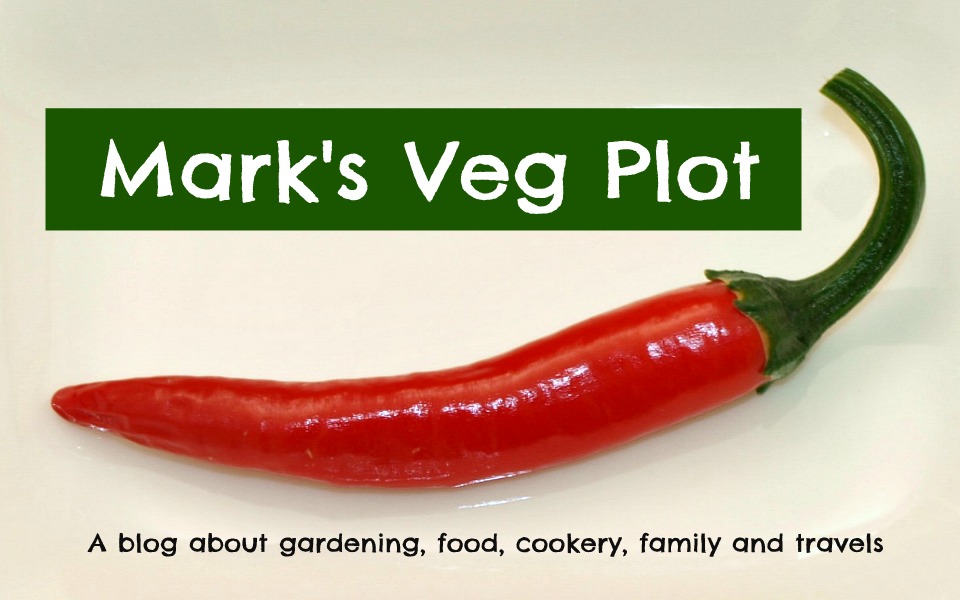This is my answer: the "Kingfisher Seedling Greenhouse".
| Seedling Greenhouse (foreground) and 2-tier mini Greenhouse (background) |
This thing is probably intended to protect trays of young seedlings, but I use it to hold my pots of potatoes, and later in the year, chillis. It comfortably hold 9 of the pots I use.
The pots "left out in the cold" are covered with the wire shelves which are supplied with the Mini Greenhouses. Held in place with bricks like that they are a minor deterrent to opportunistic browsers of the vulpine sort! That photo was taken on 28th March.
Here are the same potatoes on 7th May.
The potatoes in the Seedling Greenhouse are perhaps marginally bigger than the ones that didn't benefit from any protection, but that's not necessarily a good guide because they are of several different varieties. Anyway, this year I am taking no chances - I have just ordered two of the Seedling Greenhouses (£14.99 each).
The one you see pictured above finally died last Autumn and was thrown away. Its plastic had gone brittle and cracked in many places, but I think it had done quite well because looking back through my photos I see that I certainly had this thing in Spring 2011 and I probably acquired it in 2010 or earlier. I started my blog in August 2010 so I don't have any evidence of what occurred before that time!
The greenhouses in question are not as widely available as I had expected and I had to search around a bit (I eventually ordered mine through Amazon, though I would preferred not to have done). Perhaps they are not as popular as the upright greenhouse type? They suit my purposes very well though. They are easily assembled and dismantled (no tools required). Their only significant disadvantage is that they are very lightweight and can easily blow away if left outside without anything in them. I sometimes use bricks in the corners to weight them down.
Another disadvantage is that when the lid is zipped shut it sags in the middle, and thus tends to collect rainwater. I have tried to alleviate this by stretching a cord across the middle to provide some support (see photo below). This has been only partially successful.
Better results are achieved by stretching the lid as taut as possible and pegging it to the frame with some clothes-pegs (see photo below. The pegs are orange-coloured).
I think with the new ones I may be tempted just to make a hole in the middle and ensure that it is not directly over one of the plants! Perhaps put a bucket under the hole and use this as a means of collecting the rainwater?
Anyway, my potato-protection plan is made. Do you grow potatoes in containers, and if so, what do you do to protect them?


The plastic does tend to go brittle after a while. I bought a new cover for my mini greenhouse last year, I wonder if replacement covers are also available for the type you have. I tend to start my potato containers off in the greenhouse, though I do plant some quite late so they go straight outside without any protection at all.
ReplyDeleteYes I thought about replacing just the cover, but the frame was also damaged so I do need completely new ones.
DeleteI also find string/rope supports stretch with the weight of the wet cover in my plastic greenhouses - now I tie poles (usually poles from old greenhouse frames, but canes would do) to each side of the frame across the opening (sometimes top to bottom too, depending on rainfall !). This works quite well in all but the heaviest deluges - I have found that water can collect faster than it drains through splits in the cover and the holes have a nasty habit of coalescing as the plastic ages.
ReplyDeleteI always grow my potatoes in buckets, I suspect like you for lack of ground space. It's always more fun I think to shake out the bucket when the time comes than digging for them. I tried a few pots in the greenhouse one year to see if I'd get an earlier harvest more than for protection. I didn't so haven't bothered to cover them since.
ReplyDeleteWe were expecting our seed potatoes to arrive today but it was a no show.
ReplyDeleteWell, quite jealous that you are already going with your potato crop. I'll be growing them for the first time this year but we have another 2 1/2 months to go before they are in the ground.
ReplyDeleteI used to do plastic hoop houses, but I've gotten lazy over the years. I will protect from the insects, but not typically from the weather.
ReplyDeleteI'm currently in NM at an elevation of about 7000ft, we are eating salads from my fathers coldframe. I suggested he grow some potatoes in pots as you have done. We'll see how it goes!
ReplyDeleteDavid, I hope your father gets "converted" to this method. I expect potatoes would do well at 7000ft, seeing as how they originate from the Andes!
Delete